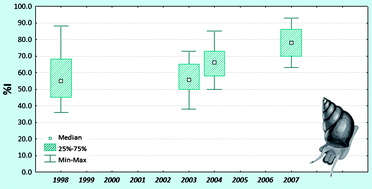Hydrobia ulvae imposex levels at Ria de Aveiro (NW Portugal) between 1998 and 2007: a counter-current bioindicator?
Abstract
Imposex expression in prosobranch gastropods has been widely used as a

* Corresponding authors
a
CESAM & Department of Biology, University of Aveiro, Aveiro
E-mail:
susana.oliveira@ua.pt
Fax: +351 234426408
Tel: +351 234370350 ext. 22752 (LEME)
Imposex expression in prosobranch gastropods has been widely used as a

 Please wait while we load your content...
Something went wrong. Try again?
Please wait while we load your content...
Something went wrong. Try again?
S. Galante-Oliveira, I. Oliveira, M. Pacheco and C. M. Barroso, J. Environ. Monit., 2010, 12, 500 DOI: 10.1039/B908597A
To request permission to reproduce material from this article, please go to the Copyright Clearance Center request page.
If you are an author contributing to an RSC publication, you do not need to request permission provided correct acknowledgement is given.
If you are the author of this article, you do not need to request permission to reproduce figures and diagrams provided correct acknowledgement is given. If you want to reproduce the whole article in a third-party publication (excluding your thesis/dissertation for which permission is not required) please go to the Copyright Clearance Center request page.
Read more about how to correctly acknowledge RSC content.
 Fetching data from CrossRef.
Fetching data from CrossRef.
This may take some time to load.
Loading related content
